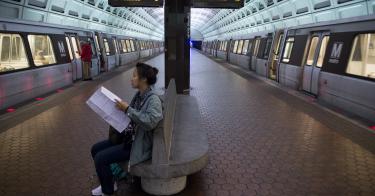The Washington Metropolitan Area Transit Authority (WMATA) announced that its long-awaited rail line connecting Virginia’s Dulles Airport with downtown Washington, D.C. is ready to open. But despite spending $6 billion to build the 30-mile Silver Line, about $200 million per mile, there’s one problem: Metro has no trains to take passengers from the airport in the Virginia suburbs to the Nation’s capital.
Trains aren’t available because most of Metro’s 7000-series rail cars, built by the Japanese firm Kawasaki, are sidelined due to safety concerns. These 748 cars are supposed to form the backbone of the Metro system. Currently Metro has too few trains in service to run its existing system in a timely manner, and opening the new line service to Dulles Airport would syphon rails cars from established lines, leaving their riders with even longer wait-times between trains.
If Metro were a private company, it would be out of business by now. But since it is nourished by a stream of taxpayer funds, it continues not only to operate but to try to expand.
If the land allocated for the rail line had instead been constructed as a dedicated busway, at a fraction of the cost, small shuttle buses and larger Metro buses could have immediately started ferrying millions of passengers from the airport to their surrounding destinations, and from their homes to the airport. No maintenance would have been needed for the tracks, and the system would not rely on the defective 7000-series trains.
>>> If You Like Your Uber, Can You Keep Your Uber?
The cost of a four-lane suburban highway is about $5 million per mile; so 30 miles would cost $150 million, or 2.5 percent of $6 billion. Even if, with cost overruns, the price tag doubled to $300 million, this would be only 5 percent of the $6 billion spent on the Silver Line.
The fundamental problem is that people do not want to pay the true costs of expensive Metrorail systems, and so costs are subsidized by federal, state, and local governments. Even with subsidies, Metro is having difficulties collecting fares, and has lost $40 million a year because, according to WMATA, 34 percent of its passengers jump over turnstiles to avoid paying. Next month Metro will start to fine riders who enter without paying.
Since the beginning of the pandemic, Congress has spent almost $200 billion on public transit systems, which include rail and buses.
That’s a lot to spend on a service whose ridership is declining. In 2022, an average of 213,000 people ride the Washington Metro system every day, one-third of the 626,000 who rode in 2019, before the pandemic. Daily rail entries peaked in 2011 at 737,000 and have been declining ever since. Washington, D.C., is tops in the country for telecommuting, because many Federal employees prefer to work at home. This means the Metro’s low ridership levels are likely to continue.
Even in New York City, which is faring slightly better, ridership has returned to only 60 percent of pre-pandemic levels.
Metro has faced recurring problems with unsafe trains. In 2016 it retired three types of trains due to safety concerns—the 1000 series, the 4000 series, and the 5000 series, all built by Kawasaki.
In an Oct. 17 letter to Brian Dwyer, chief operating officer of WMATA, the Washington Metropolitan Safety Commission’s Chief Operating Officer Sharmila Samarasinghe detailed the problems with the safety of the rail cars. The wheels on the rail cars have shown a propensity to derail, a problem known as “wheel migration.” Even if rail cars stay on the tracks, they could get stuck in tunnels and between stations, causing major problems for passengers and drivers.
>>> Maryland Regulations Prevent Kids From Getting to School
Ms. Samarasinghe wrote, “It is concerning to the WMSC that Metrorail may not be interested in carrying out its safety responsibilities, even going so far as to have senior leadership suggest at a public WMATA Board Meeting that Metrorail will only mitigate known safety issues if ordered to do so…. If controls in place to ensure the safety of passengers and workers are ignored, then those controls do not provide the intended level of safety for Metrorail passengers and employees.”
Washington Metropolitan Safety Commission CEO David Mayer said one culprit could be rail track defects, first identified in a 2015 engineering report. He stated in September that “Metrorail’s engineering report, completed by an engineering consulting firm in 2015, identified safety issues related to both wheel/axle assembly specifications and implementation, and to the force placed on the wheel flanges by Metrorail tracks.”
Despite low ridership, cost overruns, and a poor safety record, Metro believes that ridership will return. It has contracted with Japan’s Hitachi, Ltd., to build between 260 and 800 new 8000-series trains at over $2 million each. Hitachi is building a new factory in Hagerstown, Maryland, to supply them.
In deciding how to move forward, Metro should ignore sunk costs of past failed investments and decide how most efficiently to meet future demands of mass transit customers. In almost all scenarios, those demands can be better be met with simpler, less-costly road-based transportation, rather than rail.
This piece originally appeared in Forbes https://www.forbes.com/sites/dianafurchtgott-roth/2022/10/24/washingtons-new-6-billion-metro-line-needs-simpler-solutions/?sh=7787d0605332




